

Congress Set to Push War Powers Resolution
After Trump Starts a War with Iran
launching a war that may ensnare us for generations. It is absolutely and clearly grounds for impeachment,” wrote Rep. Alexandra Ocasio-Cortez on June 21.
By Lauren Victoria Burke
With no customary advance notice, senior members of Congress were caught off guard by the airstrikes on Iran. When President Trump ordered the bombing of Iranian nuclear sites, there was no congressional vote beforehand. Democrats in Congress are strongly making that point, as most Republicans are taking their customary position of agreeing with every decision Trump makes.
In the case of Rep. Alexandria Ocasio-Cortez (D-NY), she even added a call for impeachment because Trump once again actively ignored the Constitution.
“The President’s disastrous decision to bomb Iran without authorization is a grave violation of the Constitution and Congressional War Powers. He has impulsively risked launching a war that may ensnare us for generations. It is absolutely and clearly grounds for impeachment,” wrote Rep. Ocasio-Cortez on June 21.
Trump then wrote a June 22 message on social media about

“regime change” and Iran. The moment was a flashpoint for conflict in the Middle East during a week when Congress returns to work.
“The President has attacked another nation without
congressional authorization. There was no apparent imminent threat from Iran against the United States. Furthermore, the President’s own Director of National Intelligence testified before Congress earlier this
year that the U.S. intelligence community assessed Iran was not building a nuclear weapon,” wrote Rep. Bobby Scott (D-VA) on June 21.
Rep. Scott was referring to Trump’s Director of National
Intelligence Tulsi Gabbard, who has reportedly been out of the loop of decision making that is a core feature for most senior intelligence staff in the White House.
A War Powers Resolution,
in the Senate and Reps.
and Ro
in the House, to terminate any ongoing military action by the United States against Iran unless authorized by Congress, will be on the table in Congress this week. This week, the U.S. House returns to work, and the Senate resumes its full workweek. Congress is expected to make multi-million- and billiondollar decisions on Trump’s controversial budget that cuts health care and attempts to hand out several corporate benefits to the tech industry. Lauren Victoria Burke is an independent investigative journalist and the owner of Black Virginia News. She is a political analyst who appears regularly on #RolandMartinUnfiltered and hosts the show Comms Class on YouTube @ LaurenVictoriaBurke. She can be contacted at LBurke007@ gmail.com and on twitter at @ LVBurke.
Iran Strikes Back, Threatens Broader Conflict
By Stacy M. Brown

said, “Because Iran is rightful and is attacked, it will come out victorious.” He praised Iran’s leadership and warned that targeting Ayatollah Ali Khamenei, the leader of the Islamic Revolution, would bring “grave consequences for the entire world.” Qassem said that Iran remains united and defiant in the face of foreign aggression.
Iran’s envoy to the International Atomic Energy Agency (IAEA), Reza Najafi, called an extraordinary meeting of the agency’s Board of Governors in response to what he described as “the aggressive move of the United States and the Israeli regime” against peaceful Iranian nuclear facilities.
integrity under the UN Charter and the NPT.
Major General Abdolrahim Mousavi, chief of staff of Iran’s armed forces, vowed that Iran would deliver a “regretful response” to the attacks.
“Iran’s punishment of Israeli Prime Minister Netanyahu will continue with utmost might,” Mousavi said. He condemned what he called Trump’s support for a “fake regime” and expressed gratitude for the Iranian people’s support, promising a “crushing response” to future threats.
key US military installations in the region. Iran’s Supreme National Security Council claimed the number of missiles launched matched the number of bombs dropped by US forces during their attack on Iran’s Fordow, Natanz, and Isfahan nuclear sites. State media described the strikes as a “proportionate response” to what Iran called a breach of international law and the NonProliferation Treaty (NPT).
condemned the attack, and reserved the right to respond under international law.
In a statement posted to state media, Iran emphasized it had coordinated with Qatari officials in advance to minimize casualties. Qatar confirmed the strike, reported no fatalities,
Reuters reported hearing explosions throughout Doha. Axios reported that Iran launched six missiles during the operation.
Hezbollah Secretary General Sheikh Naim Qassem, speaking to Lebanese media,
Najafi said US airstrikes violated the NPT and occurred while IAEA inspectors were present. He added, “Responsibility for the grave environmental consequences caused by the US attack shall be borne by the United States, the Israeli regime, and the IAEA.”
According to Iranian state media, Najafi further warned that the damage to Iran’s safeguarded nuclear sites represents an “irreparable strike” on the international nuclear regulatory framework. He said Iran would continue to defend its sovereignty and territorial
Reports noted that President Trump remains in the White House Situation Room with his national security team. The Pentagon and White House are monitoring the fallout and additional threats in the region. Prior to the strikes, Fox News, the BBC, and The Wall Street Journal reported credible intelligence suggesting an imminent Iranian attack. Missile launchers were reportedly seen positioned near US targets in the Middle East.
“Iran is committed to maintaining its warm ties with Qatar,” the Iranian Supreme National Security Council said, according to state media, “and took steps to avoid endangering the brotherly and friendly country of Qatar and its people.”
authored by Sen. Tim Kaine (D-VA)
Thomas Massie (R-KY)
Khanna (D-CA)
BlackPressUSA Newswire Contributor
Photo: iStockphoto / NNPA.
Iran launches retaliatory strike on US military base - Iran’s Supreme National Security Council
Thursday, June 26, 2025
Commentary: Newsom’s Message to Trump Administration on California Power Grab Is Clear -- He’s Not Backing Down
Joe W. Bowers Jr. | California Black Media
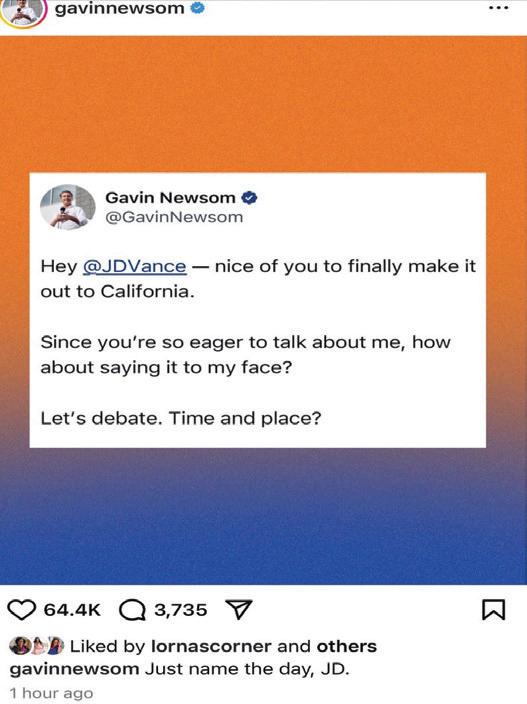
For months, Pres. Donald Trump and his allies have used California as a political punching bag.
But Gov. Gavin Newsom, who has never shied away from a political brawl -- especially with Trump -- is speaking with new force, especially after Trump’s decision to federalize the California National Guard and deploy 4000 troops and 700 U.S. Marines to Los Angeles without state approval. Calling the deployment “unauthorized, unconstitutional, and reckless,” Newsom sued the Trump administration in federal court. He also argued that Trump’s military intervention in Los Angeles violates the Posse Comitatus Act and undermines the state’s constitutional right to self-governance. The lawsuit demands that federal forces be withdrawn and that California regain control over its National Guard units. While legal scholars debate the strength of the claim, Newsom is betting that both the
courts and public opinion will side with California.
Then came JD Vance.
The Vice President’s trip to Los Angeles last week was meant to deliver a message: California is out of control, and Trump is taking charge. But instead of making the case, Vance gave Newsom exactly what he wanted -- a reason to fight, publicly and unapologetically.
Vance’s visit was short, but it was long enough to ignite controversy and underscore how sharply Newsom is responding to the Trump administration’s overreach.
Vance landed at Los Angeles International Airport at 1:35 p.m., arrived at the federal building in Westwood by 2:00 pm to meet with Marines, federal agents, and police, then staged a news conference at 3:11 p.m. in front of a fire truck—ignoring the fact that communities across Los Angeles were still recovering from devastating wildfires. The moment, scripted and performative, was like it came straight from central casting—visually polished but out of touch with the reality on the ground. By 3:30 p.m., he had left for a high-dollar Republican National Committee fundraiser at the Beverly Hills Four Seasons, and by 6:05 p.m., he was back on Air Force Two -- gone from LA in under five hours.
As Newsom’s press office posted on X:
Yes, going to the DMV is the only way to avoid a REAL ID scam
By BCP Staff
If you want to use your driver’s license to fly, you’ll need a REAL ID. If you don’t have one yet, your state’s Department of Motor Vehicles (DMV) is the place to go, and they’re only taking inperson appointments. But people are telling the FTC that scammers are pretending to be the DMV or another government agency. Reports say these “officials” are sending messages saying you can skip the line if you pay or give them information. Here’s how that scam works so you can avoid it.
You get an unexpected text or email from someone who says they’re from the DMV or the Department of Homeland Security. They say you can skip the line and expedite your application for a REAL ID. You just have to click a link to share your information and pay, they say. But this is a phishing scam to steal your money or info.
To help you avoid a scam like
this:
Know that the only way to get a REAL ID is by visiting your state DMV in person. You can’t submit an application online or in the mail. And nobody can expedite the process for you.
Don’t click links in unexpected texts or emails — and don’t respond to them. If you think the message could be legit, contact the DMV using a phone number, email, or website you know is real.
Learn more about how to get fewer spam texts and emails.If you get an unwanted message, use your phone’s “report junk” option or forward unwanted texts to 7726 (SPAM) and unwanted emails to your email provider. Once you’ve checked it out and reported it, delete the message. And if you spot a scam, report it to the FTC at ReportFraud. ftc.gov.
Pell Grants at peril: 7 million recipients face $9 billion program cut
Tuskegee President calls for full funding at Capitol Hill hearing
By Charlene Crowell
Each year approximately 7 million college students benefit from Pell Grants, a 50-year old needs-based program that can be used to cover costs for tuition, fees, living costs and room and board. Additionally, these funds have been available at both 4-year and two-year institutions. For students of color and others who are the first in their family to attend college, Pell Grants have been an important part of financial aid packages for an estimated 80 million lowincome families with little or no wealth.
But the federal Education budget for FY 2026, recently passed by the U.S. House of
Representatives, would cut Pell Grant funding by $9 billion to $22.5 billion, compared to 2024’s $31.5 billion. If approved, this significant cut will mean that next year a vital program will serve fewer students with smaller grants, changed student eligibility, and fewer institutions that would be allowed to administer the program.
Currently, the maximum Pell Grant award for the 2025–26 academic year is $7,395 and can be used by both full and part-time students.
If the Senate agrees to the House-passed budget, a maximum Pell award would
Pell Grants at peril: 7 million recipients face $9 billion program cut...continued drop to $5,710 for the 2026-27 academic year and be limited to only students completing 30 academic credit hours, or 12 to 15 credits per semester. Students completing at least 12 academic hours but fewer than full-time, would receive smaller, pro-rated grants.
Students enrolled in fewer than 12 credit hours would no longer be eligible for Pell Grants. Both community colleges and the adult students they serve would be affected by this specific change. Adult students are often employed and have dependent children with responsibilities that do not allow for heavy class loads. Even so, these students choose to return to academic studies to enhance their skills, credentials, and earnings.
At a recent hearing by the Senate’s Health, Education, Labor and Pensions (HELP) Committee a prominent HBCU president called against enacting these steep cuts.
“Today, PELL Grants provide up to $7,395 annually to more than seven million low- and moderate- income students,” testified Tuskegee University President Mark A. Brown. “For context, a single parent with two children earning up to $51,818 adjusted gross income (225 percent of the federal poverty guideline) can qualify for the maximum award.”
“However, this maximum amount covers only 31 percent of tuition, fees, room and meals at the average public four-year college, compared to 79 percent in 1975,” he continued. “Cuts to the program would put college out of reach for many more lowincome students, while increased would represent a true federal investment in education, reduce dependence on loans, and help address workforce skill deficits.”
Nor is Tuskegee alone in attacking proposed cuts. Other education stakeholders have also weighed in.
“To reduce the maximum Pell Grant when we should be doubling it, reduce the number of students eligible for Pell Grants, increase the number of credit hours necessary for Pell without consideration for students who work their way through college, and to impose risk sharing on colleges who cannot force students to make student loan payments in an increasingly uneasy economy just seems as if those who wrote this bill are
out of touch with reality,” said Lodriguez V. Murray, the United Negro College Fund’s senior vice president for public policy and government affairs.
For Katherine Meyer, a fellow in the Brown Center on Education Policy at Brookings, the proposed Pell cuts are a part of a broader retreat from a federal role in higher education.
“Between the ongoing budget reconciliation process and President Trump’s FY 2026 budget request, federal financial aid is at risk,” wrote Meyer in a recent post. “Provisions in the reconciliation bill would eliminate Pell grant eligibility for millions of students, and the budget proposes eliminating or dramatically reducing Pell and other federal grant aid. Without robust federal funding for financial aid, states and students will scramble to fill in the gaps, with the end result being fewer opportunities to pursue higher education for the lowest income students.”
On May 21, Education Secretary Linda McMahon testified before the subcommittee of House Appropriations to defend the agency’s FY 2026 budget request.
“President Trump’s vision is to make American education freer, fairer, and more competitive globally by eliminating Federal bureaucracy and empowering states, parents, and educators,” testified McMahon. “Our FY 2026 budget request delivers on this promise by reducing spending for ineffective programs and prioritizing effective ones, while fully enforcing Federal law and giving power back to states, parents, and educators.”
The nation’s broad disagreement on these and other changes to the Education Department were perhaps best summarized in another testimony at the HELP committee hearing.
According to Mark Pierce, Executive Director of the Student Borrower Protection Center: “Americans deserve more than a higher education system that acts as a finishing school for the children of millionaires and billionaires while systematically denying economic and educational opportunities to the rest of us. Our government should be relentlessly focused on making markers of middleclass American life—including education—cheaper for working families, not more expensive.”
Commentary: Newsom’s Message to Trump Administration on California Power Grab Is Clear -- He’s Not Backing Down...continued
“It was very generous of the Vice President to take time out of his closed-door fundraiser to stage a photo op in front of a fire truck -- where he mistakenly called a Latino U.S. Senator ‘Jose.’”
Vance had referred to Sen. Alex Padilla, his former Senate colleague, as “Jose Padilla,” a name associated with a convicted terrorist.
Newsom didn’t let it slide.
“JD Vance served with Alex Padilla in the United States Senate. Calling him ‘Jose Padilla’ is not an accident,” Newsom posted on X.
Then came the challenge:
“Hey @JDVance -- nice of you to finally make it out to California. Since you’re so eager to talk about me, how about saying it to my face?
Let’s debate. Time and place?” Newsom posted on Instagram.
High-Speed Rail Recognizes 17 Students Completing Central Valley Training Center Pre-Apprenticeship Program
Community/Education News
WHAT YOU NEED TO KNOW: Established in 2020, the Central Valley Training Center offers hands-on, 10-week pre-apprenticeship training to prepare students for careers in the construction trades. To date, 268 graduates have completed the program, moving on to join unions, work for subcontractors, and contribute to high-speed rail construction in the Central Valley.

SELMA, Calif. – The California High-Speed Rail Authority (Authority) today celebrated 17 new graduates of the Central Valley Training Center (CVTC) in Selma. Since launching in 2020, the 10-week pre-apprenticeship program has graduated 268 students, helping them launch careers in the skilled trades.
At a ceremony held at the Selma Arts Center, graduates Jose Ponce of Visalia and Alexa Valdez of Hanford shared their stories and future goals.
Ponce, inspired by friends who had previously completed the program, said, “My goal is to join a union—hopefully with the cement masons or carpenters. After learning from tradespeople, instructors, and business partners, I’ve gained a new perspective. I want to help build bridges, maybe even work on high-speed rail one day. Seeing the Hanford Viaduct under construction—it’s history in the making, and I want to be part of it.”
For Valdez, the program was a path out of warehouse work and a step toward continuing her grandfather’s legacy.
“He was a cement mason, and I used to help him. I like working with my hands—I’m not made for an office. I saw this
opportunity and took it. My next step is getting a union job,” The CVTC introduces students to 10 construction trades and provides hands-on training alongside journeymen from fields such as ironwork, carpentry, roofing, and masonry. Graduates also earn several industry certifications to help them enter the workforce. The program is a partnership among the Authority, the Fresno-Madera-Kings-Tulare Building Trades Council, Fresno Economic Development Corporation, Fresno Economic Opportunities Commission, and the City of Selma.
High Speed Rail Progress
Our print date is Thursdays Weekly Email Press Releases to: mary@sb-american.com continued in next 2 columns
This was the latest in a string of increasingly pointed responses from Newsom -- proof that he’s not just defending California’s autonomy but taking on the fight on his own terms.
Vance made no effort to engage with the communities affected by
the unrest or wildfires. Newsom posted that local leaders like Victoria Knapp of the Altadena Town Council were open to meeting with him and hoped he would acknowledge the wildfire damage and urge the president to approve long-overdue federal disaster aid.
Instead, during his 14-minute press event, Vance blamed Newsom and L.A. Mayor Karen Bass for the protests and accused them of encouraging violence.
Bass fired back. “We kept the peace,” she said. “You parachute into the city, pass all kinds of judgment, and then you leave. You add to the provocation and the division.”
She also blasted Vance for disrespecting Padilla, saying, “You don’t know his name, but you served with him -- and you still do. The Vice President is also the President of the Senate. How dare you call him ‘Jose’? He may look like ‘anybody’ to you, but he’s not just anybody to us. He is our senator.” Padilla responded on MSNBC: “He knows my name… It’s just an indicator of how petty and unserious this administration is. You’d think he’d take the situation in Los Angeles more seriously.”
Work continues daily on the high-speed rail project, with 171 miles currently under design and construction from Merced to Bakersfield. Nearly 70 miles of guideway are complete, along with 55 structures, with 29 more underway across Madera, Fresno, Kings, and Tulare counties. Since construction began, the project has created over 15,500 good-paying jobs—most filled by Central Valley residents. Up to 1,700 workers report to highspeed rail construction sites each day.
Commentary: Newsom’s Message to Trump Administration on California Power Grab Is Clear -- He’s Not Backing Down...continued
Still, this commentary isn’t about Vance’s blunders -- it’s about Newsom’s emergence.
He’s met Trump’s aggression head-on, matching him post for post, lawsuit for lawsuit. When Trump called for his arrest, Newsom didn’t flinch -- he pushed back.
“The President of the United States just called for the arrest of a sitting Governor. This is a day I hoped I would never see in America … this is an unmistakable step toward authoritarianism,” wrote Newsom.
And when Vance told him to “Do your job,” Newsom hit back:
“Do YOUR job. We didn’t have a problem until Trump got involved. Rescind the order. Return control to California.”
For Newsom, this is no longer just a clash of personalities or party platforms – it’s a constitutional line in the sand.
Trump’s move to override local control hits especially hard in communities of color that have long experienced the harm of militarized policing. Newsom gets that. His response isn’t just legal -- it’s personal, forceful, and unflinching.
By going head-to-head with Trump and Vance, Newsom isn’t just defending California -- he’s doing it with clarity, conviction, and a willingness to confront power directly. In a political moment defined by noise and posturing, his plainspoken rebukes are cutting through. Newsom’s words matter. He’s not just talking back. He’s pushing back, boldly and effectively. And people are taking notice. About the Author Joe W. Bowers Jr., a contributing editor at California Black Media, is a graduate of Stanford University.
Our Submission Deadline Is MONDAYS by 5 pm
Thursday, June 26, 2025
In Virginia Six Candidates Make Up the Most DEI Statewide Ticket Ever
By Lauren Victoria Burke BlackPressUSA Newswire Contributor

All eyes will be on Virginia and New Jersey as voters select a Governor and other statewide officials in those states this year.
The “off year” elections will be viewed as a referendum on President Trump. They will take place well after Trump’s budget is decided on and as many of his decisions on war, immigration and health care have hit home for many voters. Many could say that’s already happened.
But in Virginia, the question of diversity will be on the ballot as the Commonwealth presents the most diverse statewide ticket in U.S. history.
The historically diverse statewide ticket in Virginia includes an openly gay Republican white male, a Black male attorney from Norfolk, a Jamaican-born U.S. Marine
corps veteran, a Muslim woman born in India, a white woman who was a CIA officer and a Cuban American Republican. Who knew that a southern state could yield such a diverse ticket at a time when the Trump Administration has marketed heavily against “DEI” in an attempt to use it as a political weapon against Democrats?
Lt. Governor Winsome EarleSears is the GOP nominee for Governor in Virginia. Her personal story includes her father immigrating from Jamaica, where Earle-Sears was born, to support the family. She served in the U.S. Marines and is currently the sitting Lieutenant Governor of Virginia.
The Republican nominee for Lieutenant Governor is openly gay conservative talk show
Black Americans Face Unequal Burden as U.S. Inches Closer to War
BLACKPRESSUSA NEWSWIRE — As the United States edges closer to possible military action against Iran, history signals a familiar reality for Black Americans
By Stacy M. Brown

human silhouettes. Vector illustration(Photo by
As the United States edges closer to possible military action against Iran, history signals a familiar reality for Black Americans: disproportionate risk, unequal support, and a long legacy of being asked to sacrifice more while receiving less. From World War I through Iraq and Afghanistan, Black servicemembers have routinely been overrepresented in combat roles and underrepresented in decision-making positions. Today, although Black Americans make up just over 13% of the U.S. population, they account for nearly 19% of active-duty Army personnel. “When the U.S. goes to war, Black Americans, whether as civilians, enlisted personnel, or military families, often carry a disproportionate share of the burden,” Liscah R. Isaboke, Esq., Managing Partner at Isaboke Law Firm, PLLC, told Black Press USA.
“Historically, Black service members have been overrepresented in frontline and high-risk roles while underrepresented in officer ranks,” Isaboke said. “This exposure results not only in increased physical danger, but also long-term disparities in access to VA benefits, career advancement, and mental
host John Reid. Reid had to fight his own party off after he was challenged by Youngkin to drop out of the race in April after photos surfaced on social media. Instead, Reid fought off the controversy and threatened to sue a political operative of Gov. Youngkin. The GOP ticket in Virginia is rounded out by the sitting Attorney General in Virginia: Jason Miyares. Miyares won alongside Gov. Glenn Youngkin in 2021 as they defeated the ticket led by Terry McAuliffe.
On the Democratic side, former Congresswoman and CIA officer Abigail Spanberger spent six years in Congress branding as bipartisan and moderate. Spanberger appears to be extending that strategy into her race for Governor. In a May 9 interview with Vanity Fair, she stated that President Trump will not necessarily be a primary focus over issues such as the economy. But in a year that features Trump’s authoritarianism on full display, many voters on the left are calling for fire and brimstone and they’re looking for someone who will bring the heat to the Trump Administration.
With Earle Sears and Spanberger at the top of the Republican and Democratic tickets in Virginia it’s certain that the next Governor will be a woman — which will make
history in the state.
The Democrats are running State Senator Ghazala Hashmi as their candidate for Lieutenant Governor to go up against John Reid.
Hashmi has focused on progressive issues in the Virginia Senate and worked to protect health care. Her strength is that she will always be the adult in the room and will likely attract a powerful segment of the electorate that doesn’t get a lot of media attention: Voters of South Asian descent.
Finally, at Attorney General, Virginia’s Democratic nominee is former Virginia House of Delegates member Jay Jones, 36. Jones’ resume includes working as an Assistant Attorney General in the Office of the Attorney General for the District of Columbia. He is the only Black male on either ticket and will likely bring much needed help to Spanberger to win over Black voters in November.
Lauren Victoria Burke is an independent investigative journalist and the owner of Black Virginia News. She is a political analyst who appears regularly on #RolandMartinUnfiltered and hosts the show Comms Class on YouTube @ LaurenVictoriaBurke. She can be contacted at LBurke007@ gmail.com and on twitter at @ LVBurke.
Black Americans Face Unequal Burden as U.S. Inches Closer to War...continued

Behind Two Beautiful Children
BlackNews.com
health care upon return.” That overrepresentation is linked to greater economic inequality.
Recruitment data shows the military draws heavily from low-income communities, and Black Americans—more likely to face systemic barriers to college and employment—are disproportionately represented among enlistees seeking stability, education, or opportunity. Once enlisted, they are less likely to be promoted into leadership roles, often due to bias in evaluation and selection processes.
According to the VA’s National Health Study, 21.9% of deployed Black veterans screened positive for PTSD, compared to 14.1% of white veterans. Studies have shown that Black veterans are less likely to receive long-term, culturally competent mental health care and face more barriers to follow-up treatment. Military justice records also reveal that Black service members are more likely to face court-martial than their white counterparts.
“Black Americans have historically been overrepresented in the U.S. military while being under-protected both at home and abroad,” Cazoshay Marie,
a disability advocate, artist, and writer, wrote in an email to Black Press USA. “From the disproportionate impact of PTSD and other invisible war wounds among Black veterans to the lack of adequate support upon returning home, the psychological and socioeconomic costs of war weigh heavily.” “Increased military spending often coincides with the defunding of essential programs—education, healthcare, and community infrastructure—which are lifelines in our communities,” Marie said. Those federal divestments have long-term consequences. During the post-9/11 wars in Iraq and Afghanistan, it’s estimated that the U.S. spent over $6 trillion on military operations, interest payments, and veteran care. As those expenses ballooned, domestic programs—including housing subsidies, public education investment, and job training—faced cutbacks. Black Americans, already on the receiving end of wealth gaps and institutional neglect, felt those losses acutely.
In their February 2024 essay “The Race Gap That Shapes American Views of War,” published in Foreign Affairs, Naima Green-Riley of Princeton University and Andrew Leber of Tulane University wrote that Black Americans have consistently been less likely than white Americans to support U.S. wars abroad. The authors cited not only political and moral skepticism but also a deeply rooted sense that these wars are carried out in the name of democracy while offering little tangible benefit to Black communities. “Black Americans are more inclined to ask: Is this war just? Will our people gain anything from it? And what are we sacrificing for a country that so often withholds justice at home?” Green-Riley and Leber wrote.
The article pointed to cultural responses, including KRS-One’s 2008 track “Our Soldiers,” which critiques the Iraq War and opens with a siren that initially
evokes U.S. policing. The song’s hook, “Frontline of the political war,” highlights a dual consciousness: the experience of fighting abroad while being targeted and marginalized at home. “As a historian of public health and policy, I can say that when the U.S. goes to war, Black Americans often shoulder a disproportionate share of both the burden and the consequences— on the battlefield and at home,” Dr. Zachary W. Schulz, of the Department of History at Auburn University, told Black Press USA. “Historically, military service has been a double-edged sword for Black Americans,” Schulz said. “From the Civil War through Iraq and Afghanistan, Black soldiers have fought for freedoms abroad they were denied at home. Military service offered mobility, education, and sometimes even a pathway to civil rights advocacy—as in the case of the Double V campaign during WWII—but it also exposed Black personnel to racism within the ranks, limited advancement opportunities, and post-service disparities in veteran care.”
“Civilians are also deeply affected,” Schulz said. “Wars often fuel economic shifts and labor demands that open up jobs for Black workers—only to see those gains reversed when the war ends. Wartime policing and surveillance disproportionately target Black communities, and anti-war protest movements led by Black activists—think Muhammad Ali or Martin Luther King Jr.’s ‘Beyond Vietnam’ speech—have historically met with state suppression and public backlash.”
“The impact is layered,” Schulz added. “Black Americans are overrepresented among the fighters, underresourced in the aftermath, and frequently erased from the national narrative of sacrifice.”
“We must tell the full truth,” Isaboke concluded. “Black Americans have always shown up for this country, even when this country has not always shown up for them, especially in times of war.”

Nationwide — Kianna Jackson, a 25-year-old African American mother of two, was tragically shot and killed at a McDonald’s in Brandon, Mississippi, leaving behind a 5-year-old daughter and a 3-year-old son. The senseless act of violence unfolded at the McDonald’s located at 132 Stribling Lane. According to police, she was shot by 27-yearold Jhonterryes Dampier, who then turned the gun on himself. According to KGNS News, Kianna died at the scene before emergency responders could save her. The man who killed her was rushed to a nearby hospital in critical condition but succumbed to his injuries two days later. Authorities have not released a motive for the shooting, but the case remains under investigation. Loved ones describe Kianna as
a devoted and cherished mother who always put her children first. A GoFundMe page created in her honor says she had “a bright spirit” and “touched the hearts of everyone she met.” The fundraiser has been launched to help cover her funeral and burial expenses.
“As we navigate this painful time, we want to honor Kianna’s life with the memorial and funeral service she deserves,” the family wrote. “Unfortunately, the financial burden is more than we can manage on our own.” Any funds remaining after funeral costs will be placed in a trust for Jackson’s young children. Her sudden death has left the community heartbroken and sparked renewed calls for domestic violence awareness and gun safety.
The State Capital of Virginia, the House of Delegates Chamber. This is where the 100 state delegates assemble for their annual legislative session in Richmond. Photo: iStockphoto / NNPA.
Group of black people. Crowd of people. Stronger together concept. Solidarity of different men and women. Different
Iryna Alekseienko)
Young Black Mom of 2 Killed at McDonald’s, Leaves
Thursday, June 26, 2025
Disabled Californians Promise to Fight Back as Sacramento Proposes Cuts to Services They Rely On
Antonio Ray Harvey | California Black Media
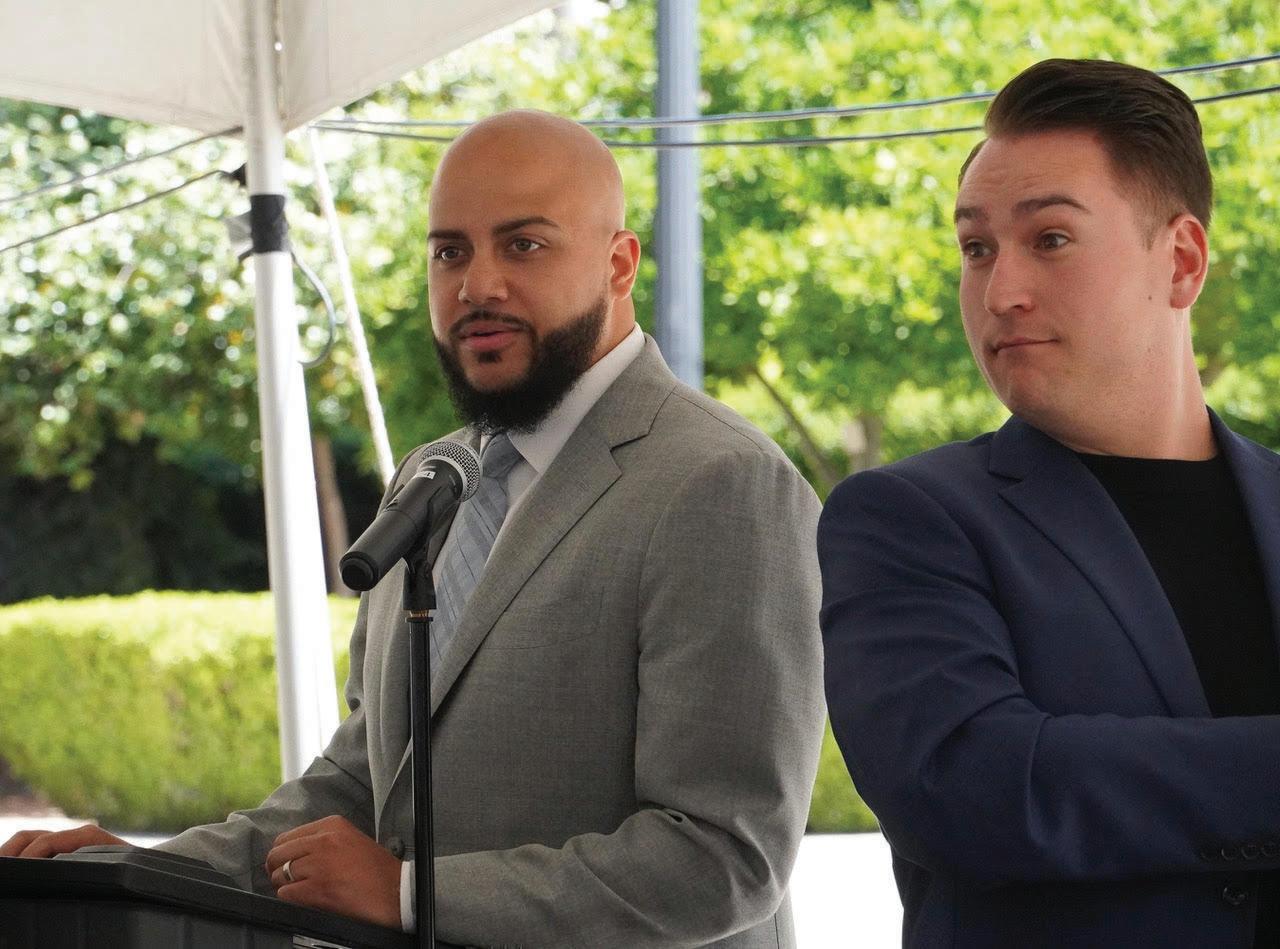
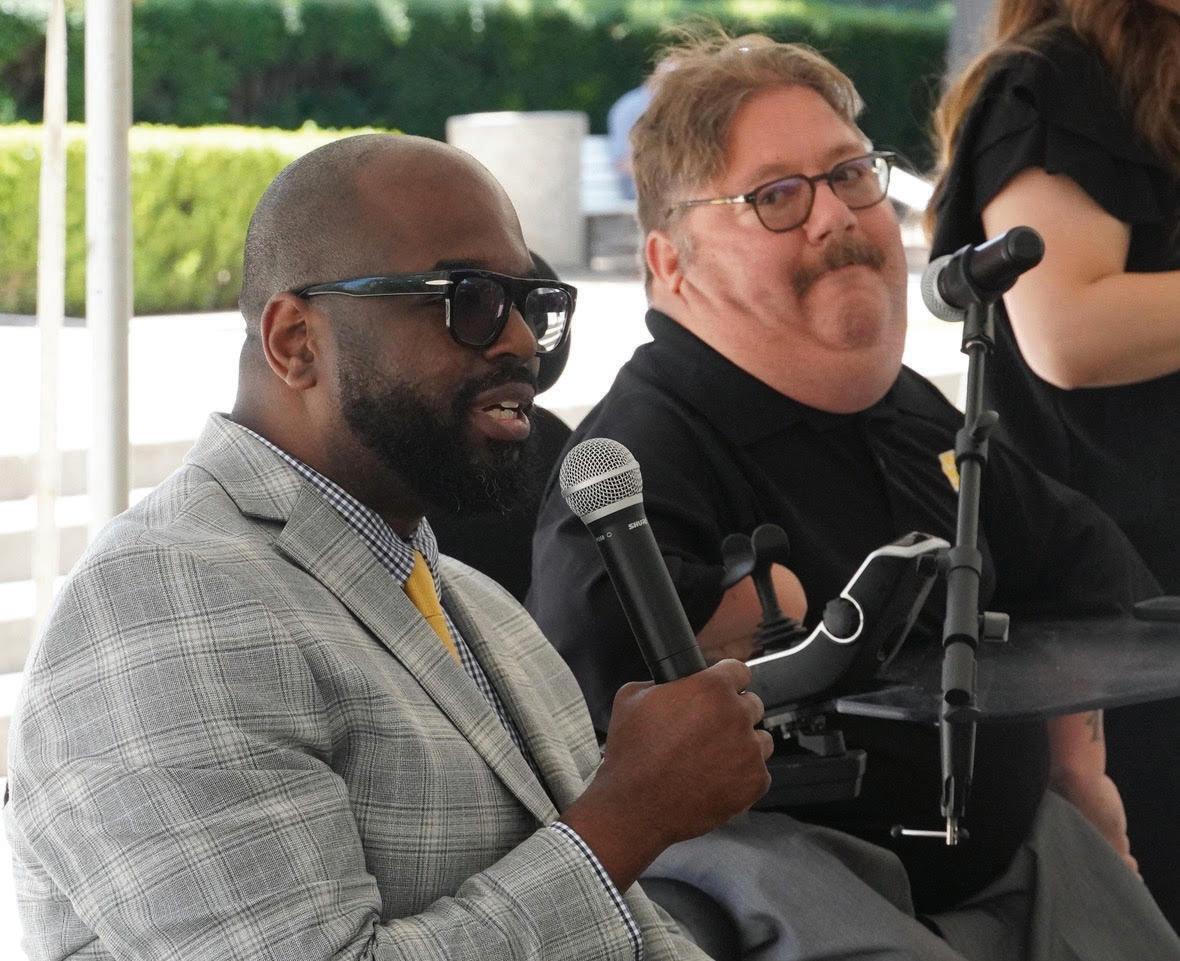
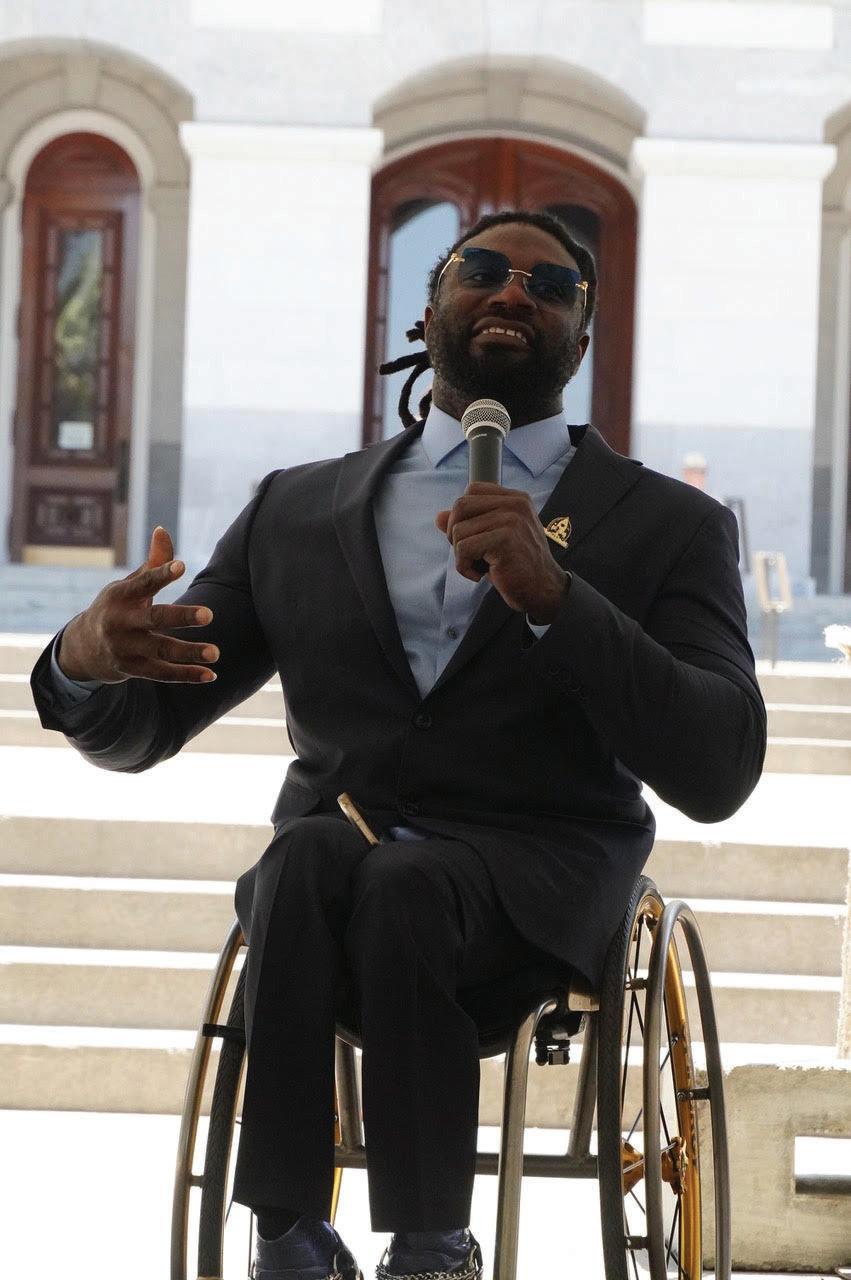
The California Disability Leadership Alliance (The Alliance) held its “Day at the Capitol” event on June 16, organized to advocate for policies and services that improve the lives of people with disabilities.
The effort’s leaders also want to strengthen what they refer to as “cross-disability collaboration” in the state.
Eric Harris, Associate Executive Director at the Sacramento-based Disability Rights California (DRC), said voices representing people with disabilities need a seat at the table when decisions are being made.
He added that people with limited abilities won’t “sit or stand” for some of the budget reductions some lawmakers and the Governor’s office are proposing that will directly impact them.
“It’s really important that folks in that building (State Capitol) hear us and see us,” said Harris, who is also an attorney.
“We’re not going to go for coercive approaches to mental health and homelessness, Harris continued. “We're not going to stand for cuts to services that we depend on every day, including in-home support services.”
The Alliance of organizations that participated in the “Day at the Capitol” event was comprised of leaders from disability advocacy and service-focused organizations, including DRC,
the California Foundation for Independent Living Services (CFILS), NorCal Services for Deaf and Hard of Hearing, Disability Rights Education and Defense Fund, and Cal Voices.
“We need this moment of power,” said Russell Dawson Rawlings, CFILC's Communications and Strategic Partnerships Manager.
Assemblymember Isaac Bryan (D-Ladera Heights), known for his advocacy work on issues related to disability rights, was one of the guest speakers, along with Assemblymember Liz Ortega (D-Hayward).
Bryan, the vice chair of the California Legislative Black Caucus, said he and Assemblymember Tom Lackey (R-Palmdale) are working on a number of bipartisan bills focused on improving disability services. He also shared that he and other lawmakers are concerned about probable cuts to the In-Home Supportive Services (IHSS) program.
Gov. Gavin Newsom’s proposed budget cuts for the IHSS program include a reduction of $707.5 million in General Fund spending, mostly through capping provider overtime and travel hours from 66 hours per week to 50.
The IHSS program provides in-home assistance to eligible aged, blind, and disabled individuals.
Bryan said his mother’s experiences as a care worker and a foster parent brace his commitment to advocating for people living with disabilities.
His own memories, too, of growing up in foster care as one of the “hardest to place cases,” and having experienced “deep trauma” and knowing other youth with “multiple disabilities” also drive his passion.
“As a legislator, it is important for me to do all that I can so that all of our policies that we move in this big building are just like my mother --someone who sees everybody, inclusive of everybody, and fights for sensibility for everybody,” Bryan said.
“When the governor put out his May Revise Budget and he had major cuts to IHSS with new income restrictions on Medi-Cal, we pushed back. We pushed back hard,” Bryan said. “We were able to stop those cuts to IHSS.”
According to the Department of Justice’s Civil Rights Division, California disabilities are “broadly defined” as conditions that hinder a major life activity, including physical and mental disabilities.
The California Department of Health Care Services (DHCS) reported that one in four adults living in California has a disability. Individuals with disabilities have a higher frequency of certain diseases, higher rates of morbidity and mortality, and risk factors for poor health.
A December 2023 survey by the California Health Care Foundation (CHCF) found that Black Californians with disabilities are more likely than those without disabilities to be covered by Medi-Cal (30% vs. 20%) or Medicare (32% vs. 14%), and less likely to have private insurance (34% vs. 64%).
That same survey revealed that approximately 19% of Black Californians reported having a disability, and people in that group are frequent users of the health care system.
The Los Angeles-based,
Black-owned research firm EVITARUS conducted the “Listening to Black Californians” study for CHCF in 2021.
Assemblymember Jeff Gonzalez (R-Indio) says he has a personal reason to be concerned about cuts to IHHS. He is father to a son named R.J., who has severe disabilities due to Cerebral Palsy (CP) with spastic quadriplegia, the most severe form of CP.
Gonzalez told California Black Media (CBM) that R.J. needs personal care “around the clock” -- a wheelchair assistant, nutrition, hygiene, medication, therapy, and social interaction.
Gonzalez feared that cutting inhome care workers’ hours would lead to multiple issues. Parents would have to spend more time at home than work. It could also lead to patients experiencing severe depression should they be unable to communicate their needs, or it could leave parents with no choice but to place their loved ones in mental institutions.
“The governor’s proposal to reduce IHHS overtime hours from 70 to 50 hours isn’t just a budget cut. It’s a direct blow to families like mine,” Gonzalez said. “It means fewer hours of trained care. It means that a parent working full-time as a caregiver may suddenly lose critical hours of paid support and may be forced to go it alone.”
Matt Scott, a Black five-time Paralympian and two-time gold medalist for Team USA Wheelchair Basketball, was one of the speakers at the event held in front of the State Capitol. He said people with disabilities are connected to a “capable community,” but services that are offered by the state are sorely needed.
“These are some challenging times,” said Scott, who was inducted into the Wheelchair Basketball Hall of Fame. “But that’s the power of adaptive sports. It taught me how to advocate, communicate, be a leader, and rise above challenges. That’s why I came here to support our cause.”
Tips To Consider To Help You Stay Healthy During Summer Travel
By Dr. Amit Arwindekar, Medical Director at UnitedHealthcare Global
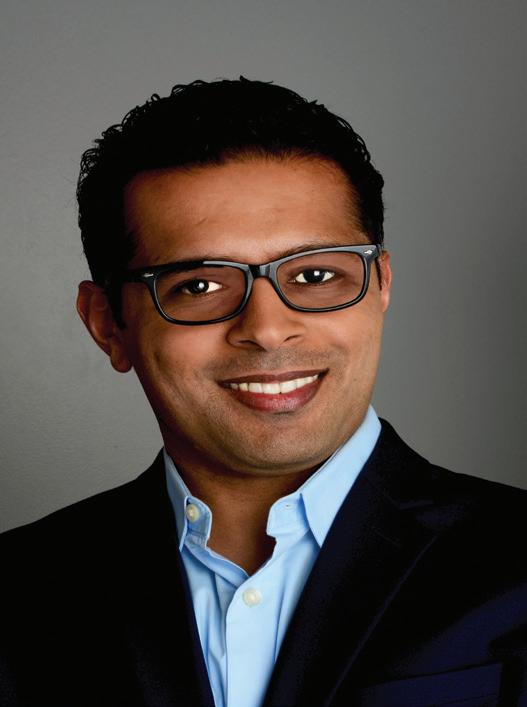
Americans report getting sick or hurt on a vacation and 56% needed medical treatment as a result. To help you prioritize a healthy and safe trip, consider these tips: Check-in with your primary care doctor before traveling. Schedule an appointment with your doctor prior to your vacation. At your visit, inform your doctor of your travel plans to see how best to support your health while traveling, including getting any recommended or required vaccinations. Before leaving, refill any prescriptions you might need while away and pack enough to last your entire trip. Check travel health information and recent travel notices for destinations abroad so you know what to expect when you arrive.
If you haven’t had an annual wellness exam and preventive screenings recently, this may be a good time to make sure you are on top of any health concerns. Health plans usually cover preventive care, which means you may pay $0
out of pocket for certain covered preventive services if you go to a network provider.
You may also consider options like virtual visits for nonemergency care. Virtual visits may be both cost-effective and more convenient. Talk to your health plan and doctor about virtual care options that might be available to you while traveling. Virtual care may help you quickly and affordably access needed care with a network provider while on the road.
Pack properly and make sure you have enough essentials. Prior to leaving home, check the weather at your destination and pack accordingly. Prepare a travel health kit with essentials like hand sanitizer, over-the-counter medications, sunscreen and bug spray. Remember to pack important items like prescription medications in your carry-on luggage in the event of an emergency, or if your checked bags get lost during travel. Take care of your health during
Tips To Consider To Help You Stay Healthy During Summer Travel...continued
insurance and travel protection. Accidents happen. That’s why it’s important to be prepared for the unexpected. That may include making sure you have health coverage while you’re away, which may help you avoid major costs in the event of an accident or sudden illness. If you plan to travel, check with your health plan to see what
coverage you may have at your destination — especially if you’re traveling internationally as many health plans may not cover medical expenses while abroad. These tips may help you stay on top of your health so you can enjoy a worry-free vacation and return home reenergized.
Shareholders Challenge Mastercard's Risky DEI Goals
Washington, D.C. -- At today's annual meeting of Mastercard shareholders, a representative of the National Center for Public Policy Research's Free Enterprise Project (FEP) presented a proposal opposing Mastercard's Diversity, Equity & Inclusion (DEI) agenda.
"Mastercard apparently continues to have a number of expressly racially discriminatory affirmative action initiatives on its books," FEP Executive Director Stefan Padfield told shareholders at today's meeting. "In fact, nowhere in its opposition statement does Mastercard even attempt to disavow the examples of express racial discrimination we cite. Instead, shareholders are given platitudes about 'inclusion' and assurances that Mastercard can't be engaging in illegal discrimination because it has policies against such things."
FEP's proposal, Proposal 8, requests that Mastercard conduct a review of how its affirmative action initiatives impact its ongoing litigation risks based on actual and perceived discrimination under relevant civil rights laws.
In its written supporting statement, FEP notes that Mastercard apparently continues to implement DEI policies despite an increasingly risky atmosphere surrounding such policies. It notes:
Mastercard plans to "grow U.S. Black leadership at the vice president level and above at Mastercard by 50% by 2025, from 2020";
Mastercard plans to "invest $500 million in Black communities"; Mastercard has "committed to increase our procurement with Black-owned businesses to $100 million annually by 2025."
"Dividing employees and other stakeholders on the basis of race
and then allocating benefits on that basis may be deemed immoral, illegal, and a breach of duty," FEP notes in the statement.
In addition to asking shareholders to support Proposal 8, FEP has published an entire voting scorecard for Mastercard shareholders as part of its Proxy Navigator voting guide, including these recommendations:
ITEM 1: Board of Directors Nominations - ABSTAIN ITEM 2: Executive Compensation - ABSTAIN ITEM 3: Ratification of Auditors - ABSTAIN ITEM 4: Approval of an Amendment to Mastercard's Amended and Restated Certificate of Incorporation to Limit Liability of Officers as Permitted by Delaware Law - ABSTAIN ITEM 5: Approval of an Amendment to Mastercard's Amended and Restated Certificate of Incorporation to remove the Industry Director ConceptABSTAIN ITEM 6: Approval of an Amendment to Mastercard's Amended and Restated Certificate of Incorporation to Implement Other Miscellaneous ChangesABSTAIN ITEM 7: Consideration of a Stockholder Proposal Requesting a Racial Equity Audit ReportAGAINST. ITEM 8: Consideration of a Stockholder Proposal Requesting a Report on Affirmative Action Risks - FOR Follow us on Twitter at @FreeEntProject and @NationalCenter for general announcements. To be alerted to upcoming media appearances by National Center staff, follow our media appearances Twitter account at @NCPPRMedia.
For Everyone Born
Michael Neuroth
Two weekends ago, over three million people joined in World Pride events across the city of Washington, D.C. Thousands of LGBTQIA+ advocates and allies filled the streets with queer pride and joy, including a 1,000-foot rainbow flag that stretched for blocks down the center of the city. It was a beautiful, exuberant couple of days. UCC churches and advocates showed up to carry signs and messages of “Love Wins!” and “Love is Louder!” across the city.
your vacation. Physical activity may help reduce stress and promote well-being. Plan to incorporate some form of activity during your vacation, such as sightseeing walks, bike rides or daytime hikes. To help avoid dehydration, carry a water bottle and refill it throughout the day. Also, make sure to wear and reapply sunscreen to protect your skin and use bug spray to keep yourself safe from bug bites. Prepare for possible jet lag. Data shows that 60-70% of longdistance travelers may experience some form of jet lag. Preparing for time changes and getting good sleep prior to travel may help reduce symptoms of jet lag. Make sure to drink lots of water. At your destination, soak in the sunlight as this may help reset your internal clock to help promote better sleep, which may be key to reducing jet lag and supporting your immune system.
Consider travel medical
Thousands marched in the historic “International Rally + March on Washington for Freedom” in protest of the policies of exclusion and erasure being promoted by some in D.C. Just one week later, the streets of D.C. were shaking again. This time, the streets were filled with a $45 million military parade that included 6,000 uniformed troops and 60-ton tanks with helicopters and bombers overhead. While some viewed this display with patriotic pride at American military strength, millions gathered at “No Kings” rallies across the nation saw it as a shameful display of autocracy and adoration of a Pentagon budget that accounts for over half of our federal discretionary spending.
It has been a dramatic, headspinning few weeks here in our nation’s capital. Yet, there was another, less public moment that took place in between these two major rallies. It was the closing prayer offered during a “Pentecost Witness for a Moral Budget” rally on June 10.
There, faith leaders and advocates gathered to decry the “Big Beautiful Bill” that will push as many as 16 million people off essential health
care (Medicaid) and cut $300 billion from food stamps (SNAP). The bill would specifically impact vulnerable communities such as the LGBTQ+ community and veterans that rely disproportionately on such programs to survive.
At the rally, one soft voice stood out to me above the rest. When given the microphone to close the event, Bishop Mariann Budde began to sing the simple and humble words of the hymn “For Everyone Born” by Shirley Murray: “For everyone born, a place at the table, for everyone born clean water and bread, a shelter, a space, a safe place for growing, for everyone born, a star overhead…” I could not hold back the tears. It was a simple yet profound protest against the cruelty of this budget bill. The words portray the “kindom” I
Today,
WITNESS FOR JUSTICE Issue #1260
Lifestyle News
Eric Harris from Disability Rights California, left, and Russell Dawson Rawlings from California Foundation for Independent Living Centers, right, hosted the event at the State Capitol on June 16. CBM photo by Antonio Ray Harvey.
Alongside a sign language interpreter, Asm. Isaac Bryan (D-Ladera Heights), left, shares his experiences of living in foster care with individuals with disabilities. CBM photo by Antonio Ray Harvey.
Paralympian Will Scott talks about his experience of thriving in adaptive sports. CBM photo by Antonio Ray Harvey.
Amit Arwindekar
State Department Issues Worldwide Travel Alert After Trump-Ordered Iran Strikes Spark Global Tensions
BLACKPRESSUSA NEWSWIRE — “There is the potential for demonstrations against U.S. citizens and interests abroad,” the alert warned, adding that travelers should monitor local media and be prepared for rapidly changing conditions. “The Department of State advises U.S. citizens worldwide to exercise increased caution.”
By Stacy M. Brown, NNPA Newswire Senior National Correspondent

The U.S. State Department on Sunday issued a rare worldwide travel advisory warning American citizens to exercise extreme caution abroad following President Donald Trump’s airstrikes on three nuclear sites in Iran.
The Pentagon has yet to disclose the full scope of the mission, but global reaction has been swift and largely condemning. Iran has vowed retaliation, and Yemen has officially declared its entrance into the war alongside Iran.
in 2024. However, national security experts say the current warning is more sweeping and severe due to the rapidly shifting dynamics in the Middle East and the unprecedented nature of the U.S. strikes.
Meanwhile, backlash toward the U.S. is not confined to the Middle East. Anti-American protests have emerged in Europe, Africa, and parts of Asia. Countries like Ukraine and Somalia—already deemed high-risk—remain on the State Department’s no-travel list, along with Iran and Israel.
“There is the potential for demonstrations against U.S. citizens and interests abroad,” the alert warned, adding that travelers should monitor local media and be prepared for rapidly changing conditions. “The Department of State advises U.S. citizens worldwide to exercise increased caution.”
The security alert followed Operation Midnight Hammer, a mission that saw U.S. B-2 stealth bombers strike Iranian nuclear facilities, marking a dramatic escalation in an already tense standoff between Israel and Iran.
The strikes—described by international observers as “reckless”—have triggered immediate global backlash, prompting protests across multiple countries and raising fears of retaliatory attacks against American travelers and interests. In its alert, the State Department cited the potential for demonstrations targeting U.S. citizens and noted that escalating conflict in the Middle East has already led to periodic airspace closures and widespread travel disruptions.
Adding to the growing list of advisories, the State Department has also updated guidance for India, issuing a level-2 travel alert over concerns of “rape, violence, and terrorism.” The advisory explicitly warns women not to travel alone and highlights India’s high rates of sexual violence and terrorist activity at tourist destinations and public areas.
Sunday’s caution follows a series of similar alerts in the past two years, including advisories related to the IsraelHamas conflict in 2023 and rising anti-LGBTQ+ violence
Travelers are urged to enroll in the State Department’s Smart Traveler Enrollment Program (STEP) to receive real-time updates from U.S. embassies and consulates. Additionally, American citizens abroad are advised to develop independent evacuation plans, as U.S. government assistance may be limited in certain regions.
U.S. officials are emphasizing vigilance.
“There’s no telling where the next flashpoint will erupt,” USA TODAY quoted a former senior intelligence official. “But Americans should be aware that we’re entering an extremely volatile period where simply holding a U.S. passport can make you a target.”
The State Department’s full alert and country-specific advisories can be found at travel. state.gov.
Lessons From a Team That Helped 27 Family Childcare Programs Get Started in a Year
BLACKPRESSUSA NEWSWIRE — The statewide project had many components, including start-up grants of up to $10,000 and business grants of up to $5,000 for access to business training, software, or devices to manage programs.
By Liz Bell, EdNC.org
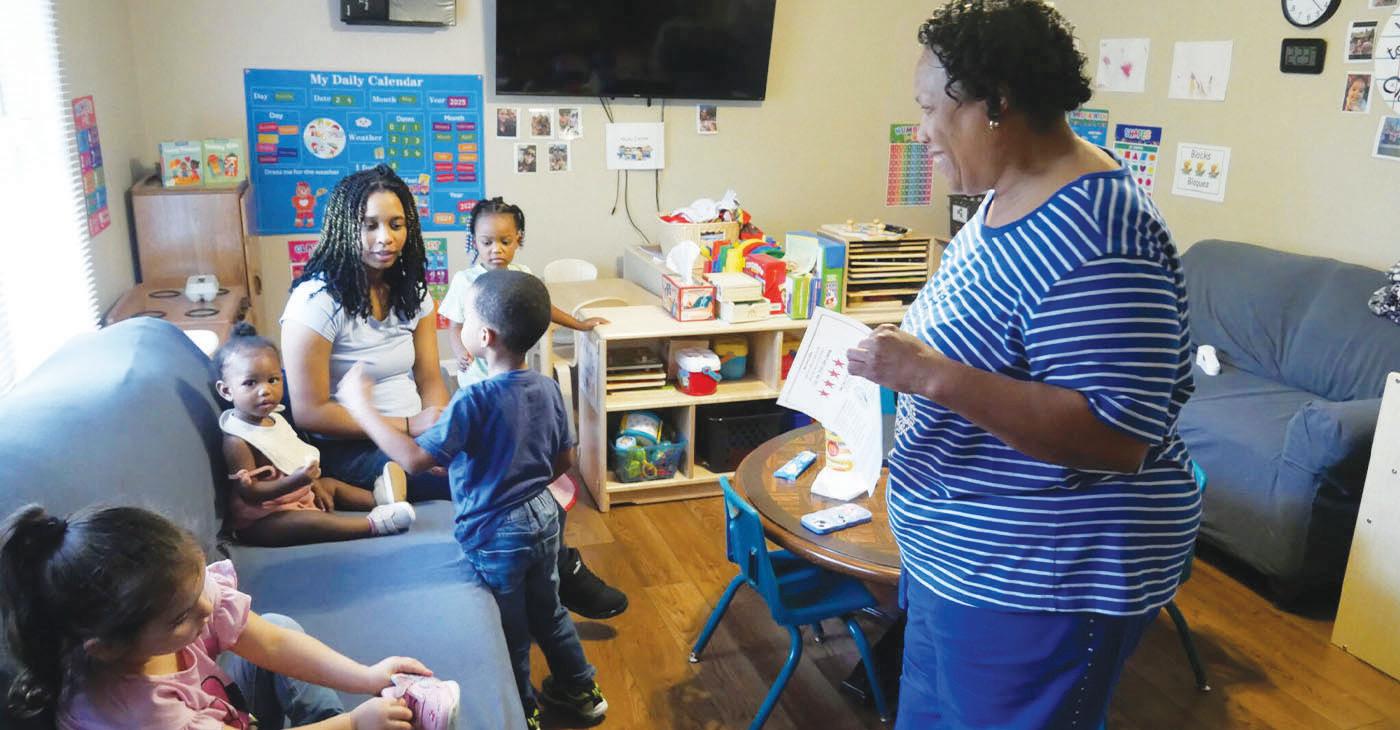
Helen Cole said her family childcare home has better equipment and provides higher-quality care because of the support she received from the Southwestern Child Development Commission’s family child care projects. Liz Bell/EducationNC
Many want to expand family childcare — the home-based sector of licensed childcare — and are looking at pilots to open new programs to meet the needs of families and employers. For the past two years, a team from the nonprofit Southwestern Child Development Commission (SWCDC) has done just that, creating North Carolina’s first statewide system of support for family child care. In the past year, the organization has helped launch 27 new family childcare programs, 20 of which are open, creating at least 160 new slots for children. Two are the first family childcare programs in their counties. Since September 2023, the team has awarded start-up grants to another 26 programs and business sustainability grants to 38 programs. It has created the first statewide family childcare mentorship program, regional communities of practice, and a marketing campaign that has garnered interest from more than 200 prospective providers since April. The funding to do this work — from a North Carolina legislative pilot in the 2023 budget and a state contract through the Child Care Development Fund (CCDF) — ends at the end of June. As state leaders ask how to improve childcare access and affordability, the project’s lessons should carry forward, said Daniel Bates, the statewide project’s manager. “I just really felt like we’ve done something here, and I hope that, no matter
what, it still continues, because family childcare is so incredibly important,” Bates said. “And they are part of early childhood education.”
‘People that will be around for a while’
Expanding family childcare takes one-on-one support for new providers who often bring a passion for children but little knowledge of the complex regulations and business challenges that come with starting and operating a program, the project leaders said. It also requires funding. In 2024, SWCDC, a nonprofit focused on early care and education based in western North Carolina, was awarded $525,000 from the Division of Child Development and Early Education (DCDEE) from legislative pilot funding to expand access to family childcare. The project’s expected output was to help 18 programs get started. Instead, it has helped launch 27 programs by awarding grants to cover start-up costs. The grants ranged from $5,000 to $20,000 depending on the providers’ needs and the strategic goals of the project. The average grant was about $13,000. Providers also spent their own money to open their programs outside of the grants. A survey of some of the providers found that most had spent between $1,000 and $5,000 before receiving grants to prepare their homes and buy materials.
The new providers are in 19 counties. In Alleghany and Montgomery counties, grant recipients will be the only family childcare providers in their counties. Two providers speak Spanish fluently, according to the project leaders. At least 18 have college degrees. Four of the new providers were under 30 years old. Six were in their 30s; 10 were in their 40s. “These are people that will be around for a while,” said Vickie Ansley, SWCDC’s Child Care Resource & Referral (CCR&R) regional programs manager, and family child care in-home program activity coordinator.
That grant funding was layered onto a larger statewide family child care project the organization has been leading since February 2023 through a separate $3 million contract with DCDEE from the CCDF, the federal funding stream that helps states raise the quality of child care and helps working families afford it. The statewide project had many components, including start-up grants of up to $10,000 and business grants of up to $5,000 for access to business training, software, or devices to manage programs. It provided 64 professional development workshops to providers on a range of issues. It also created a framework for family childcare substitute pools and a database of zoning contacts and information.
Hands-on support from regional consultants
The crux of the project, however, was all about handson support and community building, the project leaders said. The project funded 17 family childcare consultants who reached 477 providers in 73 counties with coaching and consultation. The consultants, trained in the specifics of owning and operating a family child care program, were embedded in the 14 regional CCR&R hubs covering all 100 counties. “We’re talking about people located in those communities,” Ansley said. “They know the (providers), or they know somebody who knows
them.”
DCDEE employs licensing consultants who meet with all types of potential childcare owners to begin the licensure process. The licensing consultants began recommending reaching out to the regional family childcare consultants to new providers. The family childcare consultants then could provide knowledge specific to family childcare, dedicate time and energy to decipher the complexities of starting and sustaining a business, and offer support that was independent of regulatory oversight and compliance. Some of the consultants were former family childcare providers themselves.
“Prior to that, if an agency had capacity, then they provided support,” Bates said. “The services were somewhat limited, whereas this was full 100% dedication for family childcare.”
The regional consultants received business training to advise providers on budget planning, financial reports, marketing, and recruiting and retaining staff. Kathleen Hoffler, a regional consultant at the Partnership for Children of Cumberland County who once owned a family childcare home, described the role as her “dream job.” Hoffler said she has helped providers take better care of their businesses, their children, and themselves. She encouraged providers to take time off and to reach out for help. “If you’re having issues with enrollment, if you’re having issues with collecting payments from parents, if you’re having behavior issues with kids or you’re worried that one of your kids might need some developmental screening, and you don’t have anybody to talk that out with, it’s real easy to get discouraged and possibly decide it’s not for you and you’re going to close your program,” Hoffler said.
The family childcare consultants connected providers to the pilot grant opportunities and helped them budget what they needed and how they should
Photo: iStockphoto / NNPA.
Thursday, June 26, 2025
What you need to know about QR code scams and how to stay safe
by Ali Hickerson

QR codes skyrocketed in popularity during the touch-free days of the COVID-19 pandemic, and now they’re everywhere. From menus to forms and posters–who doesn’t like these scannable shortcuts to information and fast, frictionless payments?
Now QR codes also serve a much different purpose: as a tool for scammers.
In December 2023, the Federal Trade Commission warned of a new form of phishing, which occurs when a consumer receives a scam email or text with links to malicious websites. Appropriately coined “quishing,” the new scam leverages QR codes to trick people into divulging personal information.
Using the internet, scammers send emails containing QR codes that store links to malicious websites. The communications appear legitimate, as they can be received under the guise of package tracking emails or by impersonating known senders like human resources representatives or CEOs. During the third quarter of 2023, the cybersecurity platform Trellix detected over 60,000 QR code scam attempts in emails alone.
Offline, fraudsters replace legitimate QR codes with fake ones on common locations such as parking meters, menus or posters. Once scanned, links
stored within the QR code may automatically download malware, open payment websites, or bait users into providing their personal information or logins. When bad actors access sensitive data, they can overtake devices or impersonate users, furthering the scam by conning people in the victim’s networks. QR codes are accessible, but the general public is not aware of their risks. Because QR codes appear as images or PDFs that obscure their URLs, these scams can go undetected by traditional security software. The sneaky tactic also takes advantage of smartphones’ less advanced security measures compared to computers, and scams aren’t on the radar of many consumers who learned to trust QR without inspecting each pixel. For now, many “quishing” scams are slipping through the cracks.
The first major quishing campaigns hit in May 2023, targeting Microsoft users at a major U.S. energy company. By late March 2024, the volume of quishing emails spiked more than 2,400 percent, growing 270 percent on average each month. That same month, an Osterman Research and Ironscales report found that more than 3 in 4 surveyed companies, including many information technology companies, were victims of quishing within the past year. Paradoxically, nearly 4 in 5 (77 percent) respondents were “very” or “extremely” confident in their technology to size up security threats.
Cybersecurity firm Abnormal Security found about 9 in 10 (89 percent) quishing attacks detected by their technology were multifactor authorization requests designed to take users’ credentials, according to their H1 2024 Email Threat Report. The report also found that executives are overwhelmingly targeted by quishing, with 42 times more cyberattack attempts than employees in the first quarter of 2024. Executives may be at
RETIRED COUPLE
Buys T.D.s and Buys/Lends on Partial Interests
Political Playback: California Capitol News You Might Have Missed Bo Tefu | California Black Media
California U.S. Senators Raise Alarm Over Trump Admin Sharing Personal Medicaid Data With ICE
California’s U.S. Senators Alex Padilla and Adam Schiff are raising alarm over reports that the federal government is sharing Medicaid recipients’ personal health information with immigration authorities.
In a letter to top officials at the U.S. Department of Health and Human Services (HHS) and the Department of Homeland Security (DHS), Padilla and Schiff called for an immediate end to the data sharing and demanded that any information already transferred be destroyed.
“We are deeply troubled that this administration intends to use individuals’ private health information for the unrelated purpose of possible enforcement actions targeting lawful noncitizens and mixed status families,” the senators wrote.
“The decision by HHS to share confidential health information with DHS is a remarkable departure from established federal privacy protections that should alarm all Americans.”
The June 10 transfer reportedly included names, addresses, Social Security numbers, and immigration status of Medicaid
increased risk due to their higher levels of security clearance and access to confidential information that phishers desire.
Quishing is “just the first example of many other types of image-based attacks we’re going to see,” Ironscales Principal Technology Strategist Audian Paxson told SDxCentral.
Though savvy phishing scams are harder to spot with the rise of AI-based tools, consumers can feel empowered with greater awareness. Uniqode outlined tips for spotting phony QR codes and steering clear of quishing scams.
Beware of sticker scammers
Fake QR codes can look just like legitimate ones, so watch for any irregularities before you scan. If you notice that a menu or poster includes a QR code with bumps, peeled edges, or that appears stuck on, don’t scan it.
Update your phone OS and apps
The first line of defense against malicious QR codes is ensuring your phone has the latest operating system. Two-factor authentication software that confirms your identity using your cellphone or apps is another important safeguard.
Block automatic downloads
When scammers use QR codes and other image files as vehicles for malware and malicious content, automatic downloads can wreak havoc before users even realize it. Configuring email settings to block images from loading automatically can help protect users and organizations, according to a 2023 Mimecast report.
Don’t engage with unrecognized
senders—and double-check those you know
If an email from an unknown sender asks you to scan a QR code, open links, share information, or download documents—just don’t. Detection is trickier when cyberattackers use known brands like Microsoft, Docusign and Amazon, in part because scammers now leverage companies that are relevant at a given time, such as posing as Amazon ahead of Cyber Monday. If you receive a suspicious email from a known sender, call them and ask for confirmation. In short, if an email seems “phishy,” don’t engage— report it.
Don’t fall for faux urgency
Quishers use manipulative tactics to encourage immediate action, such as companies asking you to contact them to reschedule deliveries or pretending your account was breached and asking to confirm your information. To avoid a scam, the Federal Trade Commission recommends users preview URLs linked to QR codes for red flags like random strings of letters, misspellings or switched letters.
Trust your gut
Sharp instincts can also help users avoid the quishing traps. Be wary of improbable deals and emotional appeals, and never disclose personal information like Social Security numbers— the same advice for avoiding most scams.
Before you scan, exercise caution. Just like attachments and links, QR codes can be
continued in next 2 columns
What you need to know about QR code scams and how to stay safe...continued
questionable. AI-based image recognition software may be able to help detect corrupt QR codes, and hopefully security will catch
up to scammers. For now, good old common sense also works too. This article was originally published by Stacker Media.
Political Playback: California Capitol News You Might Have Missed Bo Tefu | California Black Media
California Backs South LA Black Cultural District With $3 Million in State Funding
California is moving forward with a plan to create a Black Cultural District in South Los Angeles, backed by $3 million in state funding secured by State Sen. Lola Smallwood-Cuevas (D-Los Angeles).
The effort aims to formally recognize the historic and cultural contributions of one of the state’s largest Black communities.
The proposed district will honor neighborhoods like the Crenshaw Corridor, Leimert Park, and Historic Central Avenue. The funding will go toward public art, cultural markers, and monuments celebrating Black life, history, and creativity in South LA.
“This is about uplifting the powerful narrative of Black people in California’s history,” said Karen Mack, executive director of LA Commons, a nonprofit leading the community effort. “Everyone has a story to tell, and these stories help build belonging and connection.”
The district will be formally proposed to the California Arts Council, which oversees official state cultural district designations. Supporters say it will help protect Black heritage in the face of growing threats, including gentrification,
displacement, and climate disasters.
Smallwood-Cuevas called the initiative a vital step toward long-term cultural preservation. “Without formal efforts like this, our history remains vulnerable,” she said. “I am proud to lead the charge to ensure our communities are seen, celebrated, and protected.”
To mark the occasion, LA Commons will host its annual Day of the Ancestors: Festival of Masks on June 29 in Leimert Park. The event will feature African diaspora art, performance, and ceremony, and include a special appearance by Smallwood-Cuevas.
As part of the initiative, LA Commons also released a new report summarizing early community input and design ideas. It outlines a vision for how local artists, designers, and architects can shape the district’s future.
Organizers say this project is about more than one neighborhood. It’s part of a growing statewide movement to recognize and preserve Black cultural assets and ensure they remain a central part of California’s story.
Lessons From a Team That Helped 27 Family Childcare Programs Get Started in a Year... continued from page 6
spend the funding. Since the consultants were embedded in CCR&R agencies, they could connect providers with a variety of professional development opportunities and resources. They connected providers to mentors — seasoned family childcare providers who provided a listening ear and advice on overcoming obstacles — and to communities of practice, and regional teams that met to share ideas and support one another.
Annette Anderson-Samuels, owner of Phenomenal Kids Child Care Services, a family childcare home in Kings Mountain, was one of those mentors. She said her advice to two new providers on how to advertise their programs kept them from closing. She recently helped a provider navigate a tough conversation with parents who were not following her policies.
enrollees, despite objections from the Centers for Medicare and Medicaid Services (CMS) officials. CMS warned that “multiple federal statutory and regulatory authorities do not permit CMS to share this information with entities outside of CMS,” according to the letter.
The senators are requesting legal justification for the data transfer and they are asking HHS to identify which states were involved, how the information was shared, and how DHS plans to use it. California is one of seven states reportedly targeted. Padilla and Schiff emphasized that federal privacy laws, including the Privacy Act and HIPAA, limit how agencies may use or share personally identifiable health data. They are calling for full transparency, cancellation of any informationsharing agreements between HHS and DHS, and a return to policies that safeguard public trust in health programs like Medicaid.
The lawmakers have given federal officials until July 9 to respond.
“It’s to help each other become better at what we do as childcare providers,” Anderson-Samuels said.
There were 22 mentors and 44 mentees across the state. In his decades working in early childhood, Bates said the group has been a standout. “They’ve crossed county lines to go help each other in person,” he said.
“The interest and the willingness, wanting to improve themselves, is really out there if they have the opportunity to do that.”
‘The lost segment of early childhood education’
The number of family childcare programs, and childcare businesses within a residence, has fallen by about 36% since 2018, compared with an overall 15% decline in all types of licensed childcare.
Eighty-five percent of licensed childcare closures from February 2020 to June 2024 were homebased programs. As a generation of providers ages out of the work, a lack of awareness, funding, and support — along with increased regulation — has kept new providers from entering the field,
project leaders said. The team was intentional about listening to providers’ experiences and needs before developing a system of support. Low funding from public sources and private tuition leads to low compensation for family childcare professionals. The median wage for homebased providers in 2023 was $10.20.
The team also heard about obstacles due to HOA rules and zoning regulations. They found that local ordinances were putting up barriers to new programs in some places. Septic tank requirements were among the most common and most expensive problems. “(Providers) have recognized, ‘I don’t really need to run to Raleigh; some of the challenges I have are really just in my own backyard, and I just need to talk to my town or county,’” Bates said. The team heard about the isolation many providers feel, being alone in their homes all day without a network to air ideas or lean on when challenges arise. Providers said they did not feel respected or supported by the state.
‘Like a prayer answered’
For Helen Cole, assistance and funding were key to opening her family childcare home in Taylortown in Moore County. “I just feel like this wouldn’t have been possible without the support and the funds,” said Cole, who recently earned her four-star license to care for children from infancy to 12 years old at Helen Cole’s Day Care. She received more than $17,000 to start her program from the legislative pilot funding. She bought new outside equipment, furniture, dramatic play sets, age-appropriate toys and books, a new kitchen faucet, a state-approved curriculum, and a new laptop. Cole heard about the potential grant funding for start-up costs from the state licensing consultant. She was also connected with Hoffler. Cole was excited to open after hearing about a local demand for
second-shift care. After retiring as a substitute teacher in her local school district, she needed more income and was eager to fill a community need. However, after her initial meeting with a licensing consultant, she received a long checklist of everything she had to do. She said she felt overwhelmed. “It was just so much information,” she said. “There are things on the website, but how do you adjust it for your daycare?” Plus, Cole had experience helping in her sister’s childcare program, but she did not know the ins and outs of operating a small business. Even with a background in accounting, she knew the role would be challenging. So she reached out to Hoffler for an in-person meeting. “It was like a prayer answered,” Cole said. “She broke it down for me.” Hoffler helped Cole navigate the tough decisions that come with operating a business from your home, such as how much living space she was willing to sacrifice and what renovations were needed. And she helped Cole create a budget to apply for grant funding through the legislative pilot. She gave her ideas on high-quality and age-appropriate materials. She also connected Cole with a mentor, helped her with business skills, and connected her with other resources through the Smart Start partnership. Hoffler has helped her advertise her program and hold on through the ups and downs of enrollment, Cole said. Because she needed to hire another teacher, her niece Danielle Dixon, Cole said she is breaking even but has not started making a profit or been able to pay herself. She said she has been advised that it can take nine months to a year. She said low subsidy rates and her parent’s inability to afford her private rates have also been financially challenging. She serves one student whose parents are both working, making too much to qualify for a subsidy, but cannot afford her private
rate of $200 per week. She only charges that family $85 per week. Dixon, who has been working in childcare professionally for 11 years but informally since she was 16 years old, has both of her children enrolled in the program. Dixon said her grandmother and mother, as well as three of her aunts, have worked in childcare. She decided to partner with her aunt, Cole, to return to working with young children in a creative, exploratory environment after working in public schools. Helen Cole’s Day Care opened in December in the home she was raised in, where her mother used to take care of children whose parents were at risk of losing custody. “All of our lives, we’ve had other children here,” Cole said. Both Dixon and Hoffler have helped Cole strengthen her understanding and practice of early childhood care and education. Her program’s philosophy is based on relationships, exploration, and emotional and social development. The academic foundations are added. “It’s that give and take between you and this child,” Hoffler said. “They’re going to learn more from you if you are actively engaging with them and talking to them throughout the day, than they’ll ever learn if you give them a coloring sheet and try to teach them how to stay in the lines. There are no lines in early childhood.” “That was a wow moment,” Cole said. “I understand that we have to have a curriculum, and we do, but the biggest thing is for them to develop on their own.” It is this one-on-one attention and intimate environment that make family childcare appeal to so many parents. Rural children, low-income children, and children of color are more likely to access home-based care than center-based, according to the national advocacy and research group Home Grown. It is often more affordable, continued on page 8
Thursday, June 26, 2025
The Godfather of Litigation: Black Caucus, Sec. Weber
Spotlight Civil Rights Atty John Burris in Sacramento Film Screening
| California Black Media
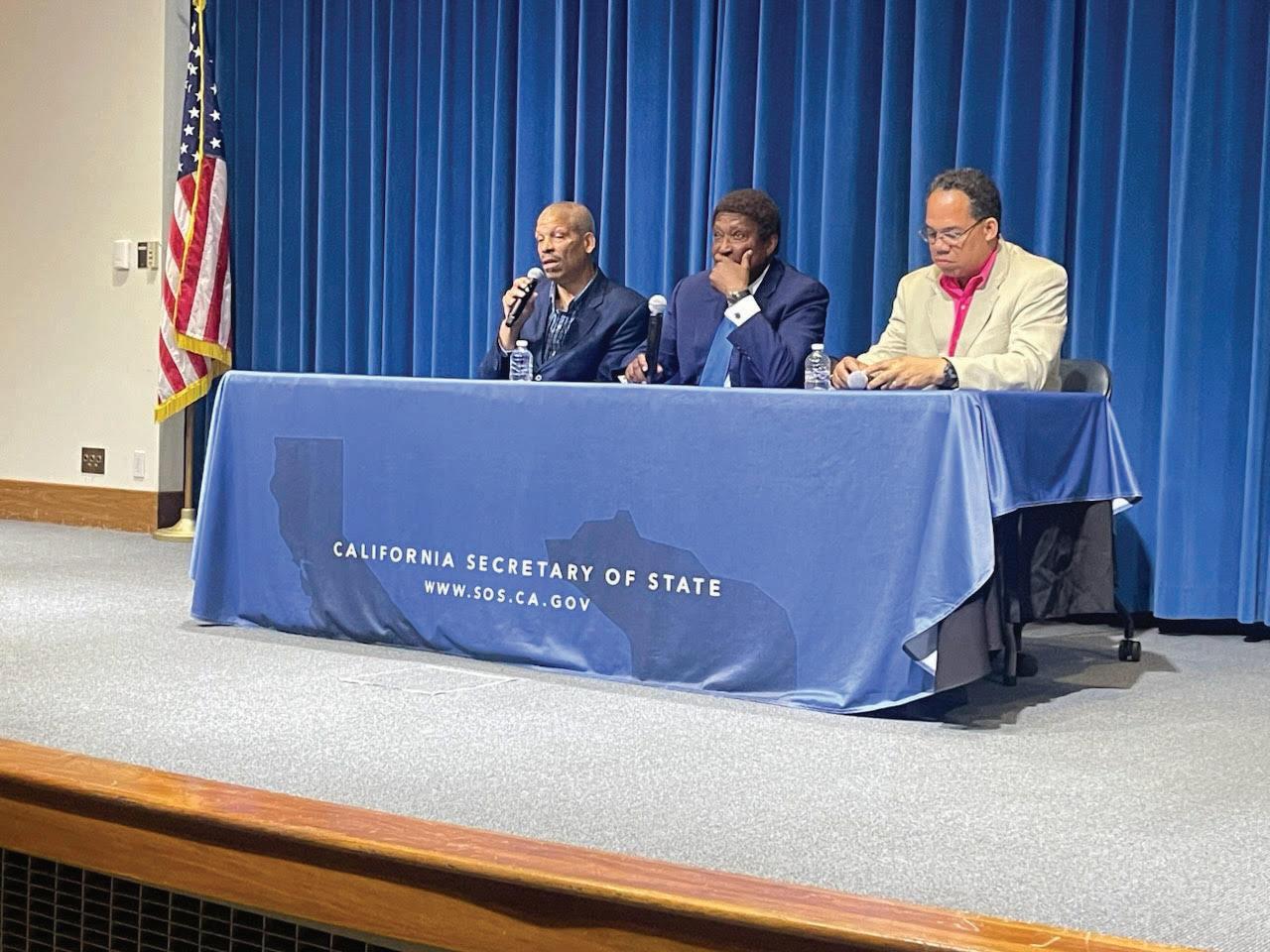

On June 16, California Secretary of State Shirley Weber and the California Legislative Black Caucus (CLBC) hosted an event in Sacramento featuring a film focused on the extraordinary career of Oakland-based civil rights attorney John Burris.
Elected officials, state employees, advocates, and others attended the 90-minute screening of the documentary film titled “John Burris: The Godfather of Litigation” at the California Museum in Sacramento.
Burris participated in a panel discussion and Q&A session after the film along with filmmaker Doug Harris and producer Brian Spencer.
Over the years, Burris, who is now 80, has won millions of dollars for clients in high-profile police brutality cases - Rodney King, Oscar Grant, Celeste Guap, Hung Lam, Melvin Black and the Oakland Riders.
But the case that perhaps most rattled the soul of Burris, California’s preeminent civil rights attorney, is the one where authorities attempted to prosecute a six-year-old Black boy from Richmond for attempted murder in the assault on an infant.
“I told prosecutors that there was no way that I was going to let them do that to that child,” Burris said recently. “Absolutely no way! They would have to get by me.”
He won that battle and many other landmark cases in a career that has spanned more than 40 years. Burris has also mentored a number of attorneys, including
current legal star Ben Crump. Tall, soft-spoken, but emphatic, Burris joined a post-screening panel with the filmmakers to reflect on his long career fighting injustice.
A 1973 graduate of the University of California, Berkeley Law School, (formerly Boalt Hall), Burris has practiced law for over four decades and has gone to trial for some 1,000 civil rights cases, including representing the late Tupac Shakur, NBA All-star Gary Payton, Barry Bonds and Sacramentan Joseph Mann. Burris, who grew up in Vallejo, earned an MBA from Cal Berkeley before turning to law.
His work on police brutality cases began in 1979 when he was an investigator in the district attorney's office in Oakland working on the case of the killing of 14-year-old Melvin Black.
The case, he says, fueled his passion, courage and lifelong legal work that garnered nationwide attention and acclaim.
Burris also authored a 1999 book about the problem of police brutality against African Americans titled “Blue V. Black.”
“In many ways it’s like I’ve been a crusader and a champion for a lot of people who otherwise would not have had representation,” Burris told the dozens gathered for the screening.
His words stirred the audience.
“This is so impactful because he is still alive,” said Weber. “He is a living legend. History is not
way back. People can see history and talk to him and ask why he did what he did. We don’t have to speculate.”
Sacramento-based civil rights attorney and law professor Mark Harris attended Boalt Hall a decade after Burris. For him, the legal giant was a role model -- and, later, a personal mentor – who was instrumental in inspiring and guiding his own career in law.
“Over the years, I have worked with John, and so have my sons,” said Harris. “So, I was very happy to be in the audience today to celebrate his unparalleled career and see his phenomenal story told in this very well sourced documentary.”
Former San Francisco mayors Willie Brown and London Breed are among those interviewed in the film.
Harris and Spencer, who both live in Folsom, interviewed some 20 people for the documentary.
The film was produced as part of a Cal Alumni Profiles documentary series, which was the creation of Spencer, who is a graduate of UC Berkeley’s African American Studies Department.
“The project highlights the outstanding achievements of some of UC Berkeley’s prominent alumni who haven’t really had their stories told,” said Harris. So, John Burris presented an extremely high-profile figure who was a perfect fit for our documentary series project. One of the most compelling things to
me throughout the production of John’s life story, was the high number of civil rights cases he’s been involved with and the incredible amount of national media coverage he has received over his long career was eye opening for me.”
Harris has been producing documentary films for more than 25 years.
“The process in many ways is similar to writing a book,” he said. “There’s a whole lot of learning you have to do before you even start the research phase to produce a compelling documentary story such as John’s, and these things don’t happen quickly. It takes a whole lot of time and planning to execute the production of a quality documentary story.
The film has been on tour, stopping in various California cities. Spencer said he expects it to be distributed by PBS and it could be broadcast on television later this year.
“The film is an important reminder about the importance of legal efforts to combat police brutality given the current administration’s retreat from investigating police departments over civil rights violations,” he said.
“I hope California legislators and others who came out to see this film, will emphasize to the public the importance of addressing racial justice in policing, because unfortunately police misconduct is still happening.”
Recipe for Disaster: Jaywalking, Texting, Speed and Speeding
Finally, the California Highway Patrol addresses “video game-styled driving” by Larry Buford


[Editor’s Note: This article was originally released in January 2023, when the new law, making jaywalking legal in California, went into effect. The article has been rewritten to include the California Highway Patrol’s (CHPs) recent announcement to deploy specially marked cars to crack down on what’s known as “video game-styled driving.” It just goes to show how lawmakers and city leaders fail to prioritize matters of importance by putting the cart before the horse. CHPs announcement has been added as number one in rank order]
Talk about a recipe for disaster; are lawmakers really paying attention to what’s going on? Finally, the California Highway Patrol (CHP) has implemented what should have been done years ago to help mitigate the ingredients of a recipe for disaster:
Recipe for Disaster: Jaywalking, Texting, Speed and Speeding...continued
4. Speed: According to the Public Health Department, death from Fentanyl use in Los Angeles County alone rose from 109 in 2016 to 1504 in 2021 and continues to rise. Cannabis (or “weed”) is legal in California for medicinal purposes as well as recreational use (for adults) and has become more easily accessible.
5. During the spike in gas prices, the Biden administration went into the oil reserves twice to try and accommodate demand and to temper pricing, but there was no caveat: Americans received no message of gas rationing like “slow down,” or “drive only when necessary.”
People continue to drive wild and free (video game-style) with no regard to gas rationing and hit and run accidents are on the rise. It’s been reported that in Los Angeles alone, a hit and run occurs every 18 minutes.
Los Angeles categorizes 50 percent of traffic accidents as hit and run, compared to the national average of 11 percent. What the CHP has done at last, should have been done first. Perhaps it would also help if automakers included warning signs on their highperformance vehicles like “Not recommended for drivers under age 21.”
Now, if only the news media would stop giving high speed chase suspects their moment of glory; and law enforcement would stop the dangerous onthe-ground engagement, our roadways would be even more safe.
Larry Buford is a contributing writer. Author of “Things Are Gettin’ Outta Hand” and “Book To The Future” (Amazon). Email: LBuford8101@hotmail. com

1. In May 2025, the California Highway Patrol announced that it is deploying new specially marked patrol vehicles across the state, in hopes of cracking down on what the agency calls “video game-styled driving.” (May 8, 2025 Online Source)
2. On January 1, 2023, a new California law went into effect – jaywalking is now legal! First introduced in 2018 by San Francisco Assembly member Phil Ting, Governor Gavin Newsom signed Assembly Bill 2147 called the “Freedom to Walk Act.” The new law decriminalizes walking outside of a crosswalk unless poor judgement has placed a pedestrian and a vehicle in immediate danger.
3. According to The Zebra – the nation’s leading insurance comparison website – texting while driving is the cause of roughly 1.6 million accidents each year. In another recent study, 60% of people texting while walking veered off course; incident or injury amounts to nearly 12,000 per year.
Lessons From a Team That Helped 27 Family Childcare Programs Get Started in a Year... continued from page 7 more convenient, and flexible for nontraditional working hours, and more culturally and linguistically relevant to diverse families. Kailyn Green, whose daughter has been at the program for a month, said she toured other programs with open spots but they “didn’t feel right.” Then she visited Cole’s program and did a walk-through. “I was like, ‘I’m sold. I’m good,’” Green said. A licensed clinical social worker, Green said she has been able to return to work without worrying.
She receives texts and videos of her daughter’s days and has been impressed by how much she has progressed, especially with eating more consistently.
“I love that she truly gets the attention,” she said. “She’s been able to form a relationship with her. It’s been great.” Hoffler said she was excited to hear about Cole’s recent accomplishment: earning four out of five stars on the state’s quality rating scale.
“I’m just so proud of her,” she said. “She handled it like a pro.”
What’s next?
There are multiple efforts to build different kinds of support for family childcare. DCDEE said the project with SWCDC taught them that “Family Child Care Homes (FCCHs) would benefit from additional funding, continued community engagement, and professional development to improve quality,” according to a DCDEE spokesperson. “FCCHs are a vital part of our state’s early care and learning network, and DCDEE
is committed to continuing our support for these small businesses,” the spokesperson said in an emailed statement. Though the contract for the statewide project ends on June 30, the spokesperson said the division will continue using CCDF funds and federal funds from the Preschool Development Grant (PDG) Birth through Five to provide business technical assistance and other services to family childcare programs. The PDG contract is in process but will be awarded to Acelero Charitable Foundation “in collaboration with multiple agencies that support family child care.” It will focus on increasing quality and family engagement, the spokesperson said. DCDEE is also contracting with Frank Porter Graham Child Development Institute at UNCChapel Hill to provide evaluation and coordination of the PDG Elevate FCCH project, which will provide extra subsidy funding to family child care programs to increase wages for providers. Jones-Ruff said SWCDC will continue supporting family childcare by retaining a statewide team with organizational funding — and will seek outside funding to continue other aspects of the project. Some of the family childcare consultants will continue their work through local CCR&R or Smart Start funding. “I can see just the monumental amount of work and the progress that has happened in such a short amount of time,” she said. “We’re not going away.”
Panel discussion following the community screening of "The Life of John Burris," featuring civil rights attorney John Burris seated alongside the film’s producer and filmmaker, reflecting on his legacy and ongoing fight for justice and police accountability. CBM Staff photo
Secretary of State Dr. Shirley Weber welcomes guests to the screening of “The Life of John Burris” at the Secretary of State Auditorium in Sacramento, California. Photo by Antonio R. Harvey, California Black Media.
Fahizah Alim
